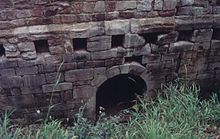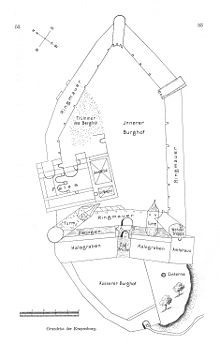
The Werra, a river in central Germany, is the right-bank headwater of the Weser. "Weser" is a synonym in an old dialect of German. The Werra has its source near Eisfeld in southern Thuringia. After 293 kilometres (182 mi) the Werra joins the river Fulda in the town of Hann. Münden, forming the Weser. If the Werra is included as part of the Weser, the Weser is the longest river entirely within German territory at 744 kilometres (462 mi).

Königstein Fortress, the "Saxon Bastille", is a hilltop fortress near Dresden, in Saxon Switzerland, Germany, above the town of Königstein on the left bank of the River Elbe. It is one of the largest hilltop fortifications in Europe and sits atop the table hill of the same name.

Sangerhausen is a town in Saxony-Anhalt, central Germany, capital of the district of Mansfeld-Südharz. It is situated southeast of the Harz, approx. 35 kilometres east of Nordhausen, and 50 km (31 mi) west of Halle (Saale). About 26,000 people live in Sangerhausen (2020).

Burtscheid Abbey was a Benedictine monastery, after 1220 a Cistercian nunnery, located at Burtscheid, near Aachen, North Rhine-Westphalia, in Germany.
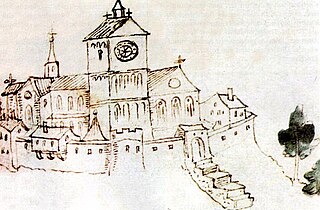
Weingarten Abbey or St. Martin's Abbey is a Benedictine monastery on the Martinsberg in Weingarten near Ravensburg in Baden-Württemberg (Germany).

Säben Abbey was a Benedictine nunnery located near Klausen in South Tyrol, northern Italy. It was established in 1687, when it was first settled by the nuns of Nonnberg Abbey in Salzburg. The last nuns left the abbey in 2021.

The Electorate of Trier was an ecclesiastical principality of the Holy Roman Empire that existed from the end of the 9th to the early 19th century. It was the temporal possession of the prince-archbishop of Trier who was, ex officio, a prince-elector of the empire. The other ecclesiastical electors were the electors of Cologne and Mainz.

Langheim Abbey was a well-known Cistercian monastery in Klosterlangheim, part of the town of Lichtenfels in Upper Franconia, Bavaria, Germany, in the Bishopric of Bamberg.

Banz Abbey, now known as Banz Castle, is a former Benedictine monastery, since 1978 a part of the town of Bad Staffelstein north of Bamberg, Bavaria, southern Germany.
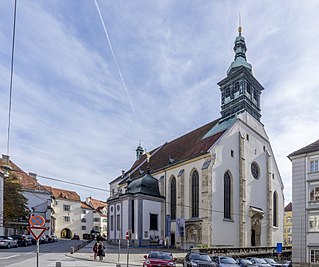
The Roman Catholic Diocese of Graz-Seckau is a Latin Church diocese comprising the Austrian state of Styria. It is part of the Ecclesiastical Province of Salzburg.
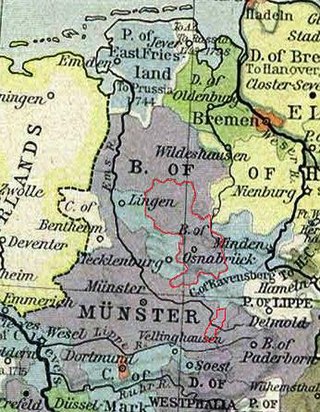
The Prince-Bishopric of Osnabrück) was an ecclesiastical principality of the Holy Roman Empire from 1225 until 1803. It should not be confused with the Diocese of Osnabrück, which was larger and over which the prince-bishop exercised only the spiritual authority of an ordinary bishop. It was named after its capital, Osnabrück.

Güssing Castle is a castle in southern Burgenland, Austria. On June 30, 1524, the castle was acquired by the Batthyány family, which retains ownership through a historical foundation that provides for the care and maintenance of the castle. Güssing Castle is 293 metres (961 ft) above sea level. Established by Béla III of Hungary around 1180, Güssing Castle is the oldest castle in Burgenland.
Tiefenort is a village and a former municipality in the Wartburgkreis district of Thuringia, Germany. Since July 2018, it is part of the town Bad Salzungen. It is situated on the river Werra, 5 km west of Bad Salzungen, and 8 km east of Vacha, Germany.

The Krayenberg is a 431-metre (1,414 ft) hill near Tiefenort, Germany. Since 500 BCE it was a rampart and served as a refuge for the central part of the Werratal. It became important for German history due to the Krayenburg, which was built on its top after 786, and destroyed starting with the Thirty Years' War. Today, the well-maintained ruins, a restaurant and a hotel define a tourist location in the Werratal.

St. George's Abbey, Isny in Isny im Allgäu in Baden-Württemberg, Germany, is a former Benedictine abbey founded in 1096 and secularised in 1802.

The House of Franckenstein is the name of a feudal, Franconian noble family in Germany, descendants from the Dynasts of the Breuberg family; offsprings of the Lords of Lützelbach from Höchst im Odenwald.
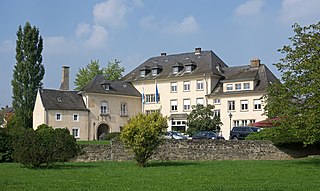
Stadtbredimus Castle, located on the banks of the Moselle in the village of Stadtbredimus in south-eastern Luxembourg, has a history going back to the 13th century when a fortified castle stood on the site. In 1724, today's castle was built on the ruins of the old fort and, after some questionable restoration work, was bought by the la Fontaine family in 1802. It was here that Luxembourg's national poet, Edmond de la Fontaine, better known as Dicks, lived from 1858 to 1881.

Jestädt is a borough of the Municipality of Meinhard in the Werra-Meißner-Kreis in the State of Hesse of Germany.

The House of Rapperswil respectively Counts of Rapperswil ruled the upper Zürichsee and Seedamm region around Rapperswil and parts of, as of today, Swiss cantons of St. Gallen, Glarus, Zürich and Graubünden when their influence was most extensive around the 1200s until the 1290s. They acted also as Vogt of the most influential Einsiedeln Abbey in the 12th and 13th century, and at least three abbots of Einsiedeln were members of Rapperswil family.

Elisabeth von Rapperswil was the last countess of the House of Rapperswil, and secured by her second marriage the female line of the Counts of Rapperswil and the extensive possessions of Rapperswil in the former Zürichgau to the Laufenburg line. Her son by first marriage was Reichsvogt Wernher von Homberg, and her oldest son by second marriage was Count Johann von Habsburg-Laufenburg who passed over the title of the count of Rapperswil to his oldest son Johann II and his brothers Rudolf and Gotfried.


